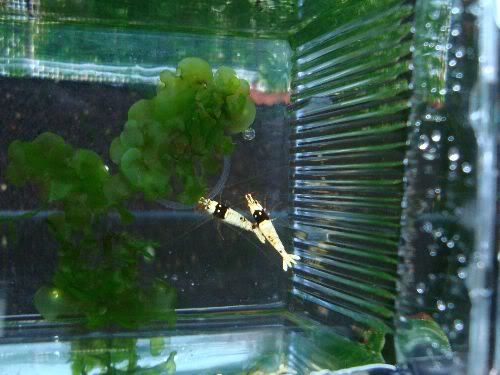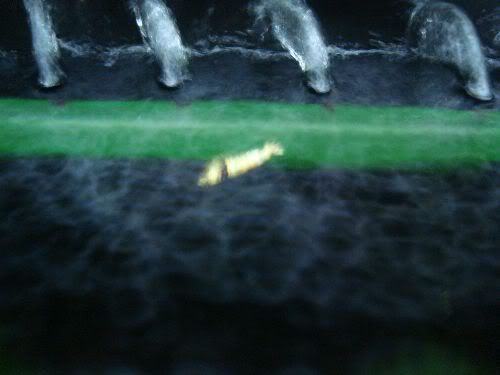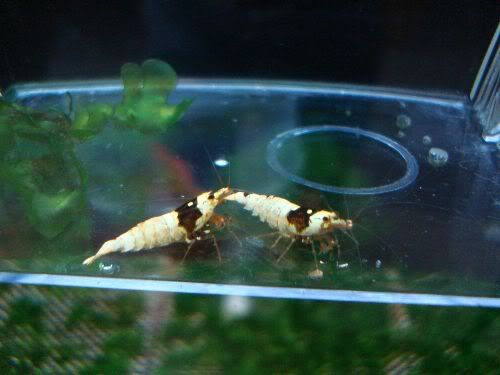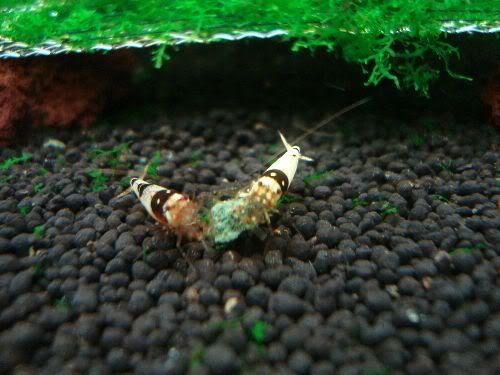On this page, we reveal how we do it here at Shrimps Online! And by that we mean breeding tips and care for your berried shrimps.
At Shrimps Online, only the best are chosen for selective breeding. This will ensure a good batch of young and quality shrimps for the future. We pick out and selectively breed those with good and strong colouration (white and red - CRS / black - BDS).
You will have to identify the males from the females. It might be quite hard to identify them at first so try to get a batch size of about 5 - 10 shrimps to ensure you get a good mix of genders. Basically, the males are slightly smaller and have shorter thinner tail sections while the females are slightly larger with a curved underbelly. There is one certain way to identify the sexes apart from each other when one female is ready to get berried. The female will release a pheromone which sends males into a frenzied dance, males will be swimming frantically around the entire tank trying to locate the female realeasing the pheromone while the other female shrimps will just be grazing as per usual.
This video shows the male shrimps in the frenzied dance around the tank:
Once you see this frenzied dance, first locate the female. She'll probably be in a remote location such as high above on the filter tube or rainbar or in a corner hidden amongst some plants.
Prepare a breeder box as such with a good amount of moss and place her in first and leave her to settle in for about 5 - 10 minutes. Now, pick out a male you wish to selective breed with this female. Remember that the males are the ones swimming frantically around the tank, don't pick out another female! The last thing you would want is two females in the breeder box =).
Place the male into the same breeder box and leave them to mate for about 20 - 30 minutes. The male should advance the female shrimp immediately and this would cause further frenzied swimming from both the shrimps in the breeder box.

(Video example with 2 Crystal Red Shrimps)
After about 30 minutes, check back to see that the shrimps are fine. You would know when the female has lost interest in the male when she just "flicks" her tail to shrug off the male's further advancements. You can now remove the male but keep the female in the breeder box for awhile longer.
After about 1 - 3 hours, you should see the female berried with little black "ball like" eggs in her belly area. You can now release the female back into the main tank.
The gestation period or the length taken for shrimplets to hatch from their eggs is about 3 - 4 weeks. During this period, you should be able to see colour changes in the eggs from the beginning - black, to the middle stage - they turn abit reddish to when they are about to hatch - almost transparent or whitish.
As mentioned before, when female shrimps are berried, try not to do any water changes. As water parameter changes or substances added into the water column such as old sea mud powder may cause shrimps to moult and berried shrimps may moult and drop their eggs in the process. New or young females who are berried for the first time may also drop their eggs due to stress and may even die during this stressful period. So try to stay away from adding or changing anything in the tank until the shrimplets hatch, even if it means waiting for up to a month!
It is apparent in our tanks that berried females always come out to eat the food (mosura specialty food) that we introduce into the tank first. However, stick to your usual routine of feeding. You do not need to increase the amount of feeding or the size of feeding. In fact, do not over feed your shrimps (read more in the "basic shrimp care" page), as parasites like planaria may start to infest your tank!
Do not switch on/ off your lights unnecessarily as switching on/ off your lights may scare your shrimps and as mentioned above, the berried shrimps are in a stressful period and any little shocks may prove fatal for them. Stick to the normal routine.
After about a month, you can now search your tank for little baby replicas of your shrimps! They will be fascinating but at the same time very hard to find! At this age, shrimplets do not require any sort of special food as sold in some local fish shops. All you need to provide is moss or plants in the tank and they would do just fine. When they grow slightly bigger in 2 - 3 weeks, they will start to eat the food (mosura specialty food) that you introduce into the tank. With some luck and most of the time when you selective breed good parents, you should get similar looking shrimplets. The word is should because you still might get 1 or 2 shrimplets that are a few grades lower than their parents but that is normal.
All you have to do is sell those grades that you do not require on the forums and continue the process of selective breeding to achive even better grades! This is how we do it at Shrimps Online. The team wishes you all the best in your shrimp breeding!
*Note: It is up to the individual to stimulate the shrimps unaturally such as by adding in "eros" or "gravidas". However, at Shrimps Online, we do not use those as we believe that mating and breeding should and would come naturally when conditions are right =).






